
|
||
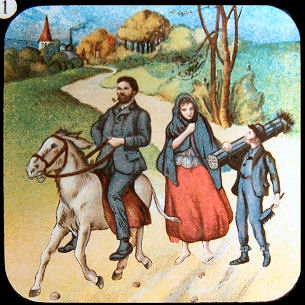 |
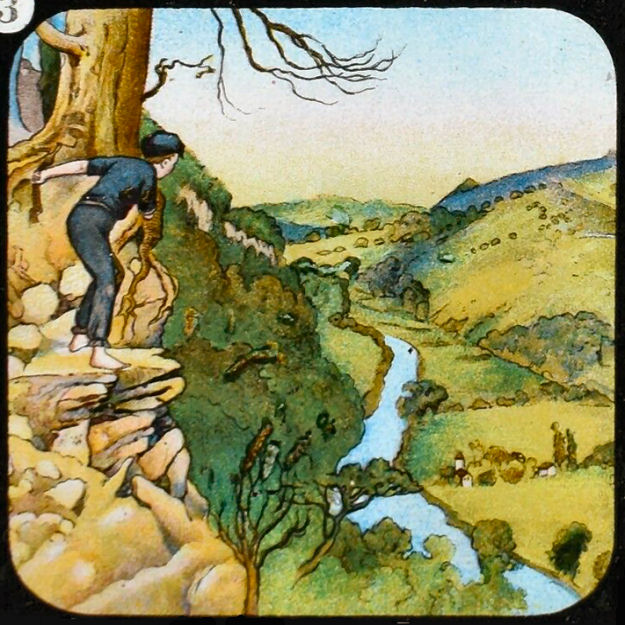 |
|
 |
||
| 1. Tom and his Master meet the Irishwoman. | 2. Tom runs away from the nurse. | 3. Tom sees a clear stream. |
|
Once upon a time there was a little chimney-sweep, and his name was Tom. That is a short name, and you have heard it before, so you will not have much trouble in remembering it. He lived in a great town in the North country, where there were plenty of chimneys to sweep, and plenty of money for Tom to earn and his master to spend. He could not read nor write, and did not care to do either; and he never washed himself, for there was no water up the court where he lived. He had never been taught to say his prayers. He never had heard of God, or of Christ, except in words which you never have heard, and which it would have been well if he had never heard. He cried half his time, and laughed the other half. He cried when he had to climb the dark flues, rubbing his poor knees and elbows raw; and when the soot got into his eyes, which it did every day in the week; and when his master beat him, which he did every day in the week; and when he had not enough to eat, which happened every day in the week likewise. And he laughed the other half of the day, when he was tossing halfpennies with the other boys, or playing leap-frog over the posts, or bowling stones at the horses’ legs as they trotted by, which last was excellent fun, when there was a wall at hand behind which to hide.......... |
||
 ........
that's the begin of the famous children's story THE WATER-BABIES, subtitled A Fairy Tale
for a Land Baby and written by the English writer Charles Kingsley. The
Water-Babies was an exceptionally popular fantasy serialized in Macmillan’s
Magazine 1862-3 then published in 1863 with Noel Paton’s illustrations. 'The
Water Babies' has been edited several times, into a film, a play, a
radio play and a musical. Many versions of the book have been made, from full, unabridged versions to
illustrated and simplified children's books. Strangely enough, however, a Dutch version has
never appeared.
........
that's the begin of the famous children's story THE WATER-BABIES, subtitled A Fairy Tale
for a Land Baby and written by the English writer Charles Kingsley. The
Water-Babies was an exceptionally popular fantasy serialized in Macmillan’s
Magazine 1862-3 then published in 1863 with Noel Paton’s illustrations. 'The
Water Babies' has been edited several times, into a film, a play, a
radio play and a musical. Many versions of the book have been made, from full, unabridged versions to
illustrated and simplified children's books. Strangely enough, however, a Dutch version has
never appeared.Read more of this story at http//www.bibliomania.com/0/0/30/991/frameset.html. |
||
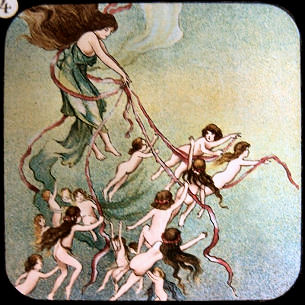 |
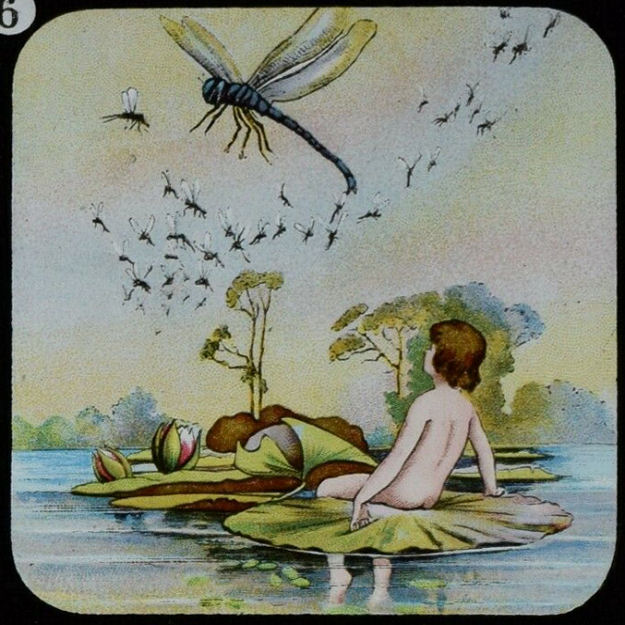 |
|
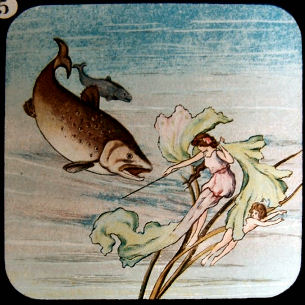 |
||
| 4. Tom turned into a Water Baby. | 5. The Fairy Queen protects Tom from the angry Trout. | 6. Tom sees a gorgeous Dragon-fly. |
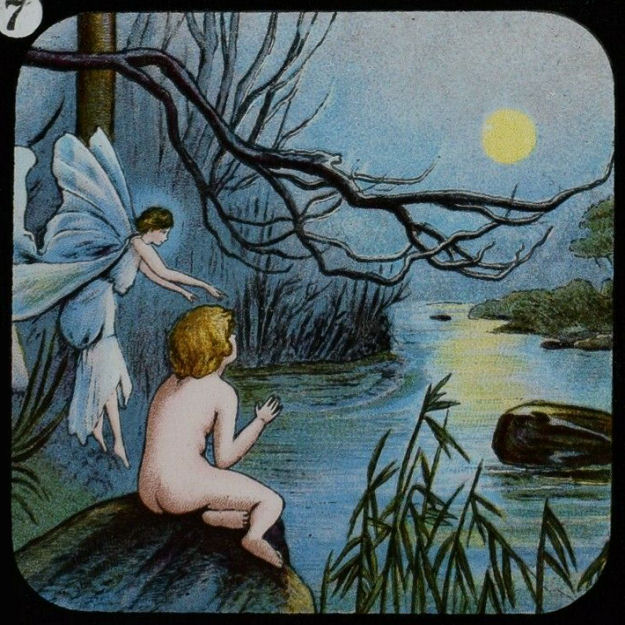 |
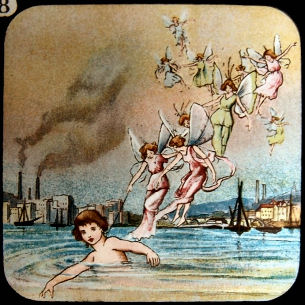 |
|
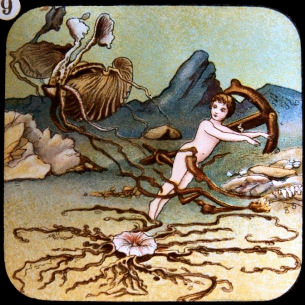 |
||
| 7. Tom watches the moonlight on the river. | 8. Past the Great Town. | 9. Tom sees the Sea Anemones. |
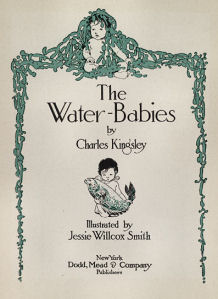 SUMMARY (Source: www.bibliomania.com): The Water-babies is the story of Tom, a young boy who is a chimney sweep employed by the brutal bully Mr Grimes.
Falling down a chimney, Tom finds himself in the presence of a girl called Ellie. Her cleanliness and neatness makes Tom
aware for the first time of his own dirty blackened body. He is chased out of Ellie’s house and falls into the river where he enters a
magical underwater world and becomes a water-baby. Like Carroll’s Alice’s Adventures in Wonderland or White’s The Sword in the Stone,
this tale explores the possibilities of an alternative world following certain transformations. Here we meet the caddis fly, the salmon and
other creatures that teach Tom morality. This is in the didactic vein of many nineteenth century texts for children, but these days some of the
sentiments of the story (particularly those which suggest the moral education of the poor) may seem patronising. Most readers, however, will
be carried away by the fantasy and its sense of hope and possibility in life just as Queen Victoria was (she read it to her children and appointed the author canon of
Westminster).
The famous characters of Mrs Doasyouwouldbedoneby and Mrs Bedonebyasyoudid appear in the story, and Kingsley portrays the water
world in a consistently vivid and exciting manner. The serious issues of whether enforced child-labour is immoral and of how the poor should be
treated are major themes in this landmark children’s tale. SUMMARY (Source: www.bibliomania.com): The Water-babies is the story of Tom, a young boy who is a chimney sweep employed by the brutal bully Mr Grimes.
Falling down a chimney, Tom finds himself in the presence of a girl called Ellie. Her cleanliness and neatness makes Tom
aware for the first time of his own dirty blackened body. He is chased out of Ellie’s house and falls into the river where he enters a
magical underwater world and becomes a water-baby. Like Carroll’s Alice’s Adventures in Wonderland or White’s The Sword in the Stone,
this tale explores the possibilities of an alternative world following certain transformations. Here we meet the caddis fly, the salmon and
other creatures that teach Tom morality. This is in the didactic vein of many nineteenth century texts for children, but these days some of the
sentiments of the story (particularly those which suggest the moral education of the poor) may seem patronising. Most readers, however, will
be carried away by the fantasy and its sense of hope and possibility in life just as Queen Victoria was (she read it to her children and appointed the author canon of
Westminster).
The famous characters of Mrs Doasyouwouldbedoneby and Mrs Bedonebyasyoudid appear in the story, and Kingsley portrays the water
world in a consistently vivid and exciting manner. The serious issues of whether enforced child-labour is immoral and of how the poor should be
treated are major themes in this landmark children’s tale.Above: Cover of The Water-babies by Charles Kingsley. New York: Dodd and Mead, 1916. First edition illustrated by Jessie Willcox Smith. | ||
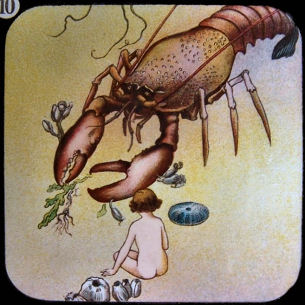 |
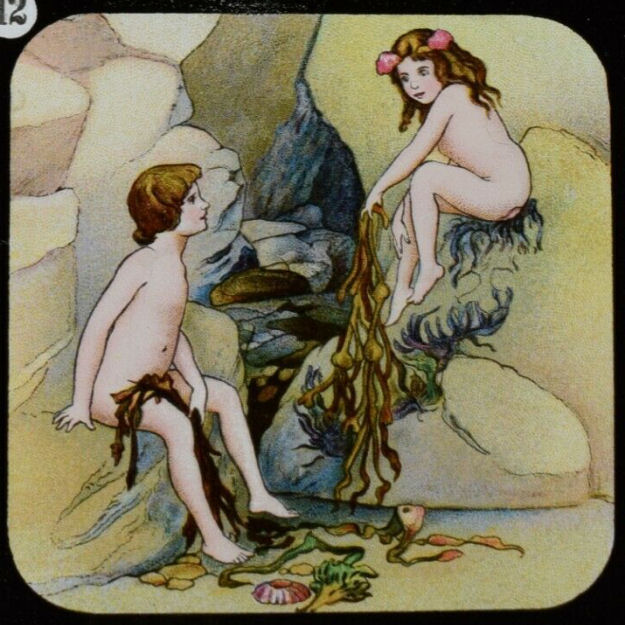 |
|
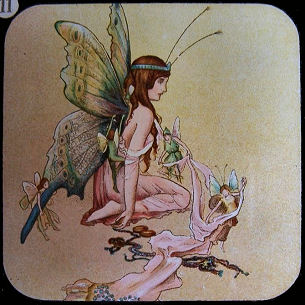 |
||
| 10. A Lobster for a playfellow. | 11. The Fairies fixing wings on Elsie. | 12. Tom finds another Water Baby. |
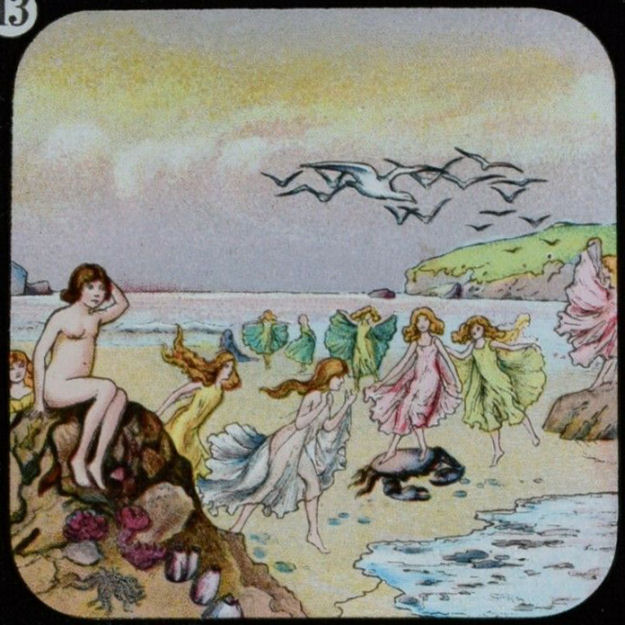 |
 |
|
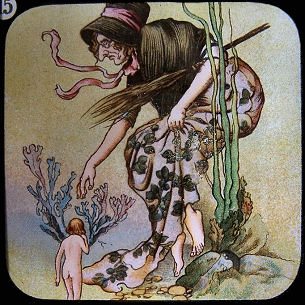 |
||
| 13. The Fairy Isle of St Brandans. | 14. Tom frightens the Crabs. | 15. Mrs Be-done-by-as-you-did tells Tom to behave himself. |
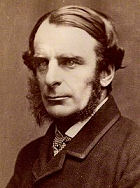 Charles Kingsley. Charles Kingsley.
Born June 12, 1819, Holne Vicarage, Devon, England. Died January 23, 1875, Eversley, Hampshire. 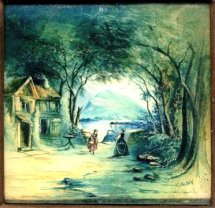 Charles Kingsley, Anglican
clergyman, teacher, and writer whose novels influenced social developments in Britain, was born in 1819
in Devonshire in a parsonage. On gaining
manhood and entering the Church, he went to Eversley, where practically
all the rest of his busy life was spent. He was one of
the few clergymen to accept Darwin's theories of
evolution and natural selection and to devote himself to the spread of
the new knowledge of nature. Though
Kingsley was a good country parson, who worked with zeal and power among
his flock, he was also a prodigious writer and a preacher of public
morality. Like Dickens he set himself, by means of novels, to draw
attention to the evils of his time. In 1863, he wrote a story for his baby
son Grenville, which was to become a long-popular children's book, The
Water-Babies. The story was inspired by his thoughts on evolution, and he
did much to encourage an interest in nature among the working people. Charles Kingsley, Anglican
clergyman, teacher, and writer whose novels influenced social developments in Britain, was born in 1819
in Devonshire in a parsonage. On gaining
manhood and entering the Church, he went to Eversley, where practically
all the rest of his busy life was spent. He was one of
the few clergymen to accept Darwin's theories of
evolution and natural selection and to devote himself to the spread of
the new knowledge of nature. Though
Kingsley was a good country parson, who worked with zeal and power among
his flock, he was also a prodigious writer and a preacher of public
morality. Like Dickens he set himself, by means of novels, to draw
attention to the evils of his time. In 1863, he wrote a story for his baby
son Grenville, which was to become a long-popular children's book, The
Water-Babies. The story was inspired by his thoughts on evolution, and he
did much to encourage an interest in nature among the working people.Above: Portrait of Charles Kingsley - View in North Devon, the county were Kingsley grew up. A rare hand painted slide. The mahogany and pine frame measures 7 inches by 5 ¾ inches. This beautiful slide is signed by the artist "Gray". Circa 1860. |
||
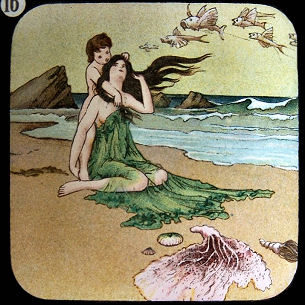 |
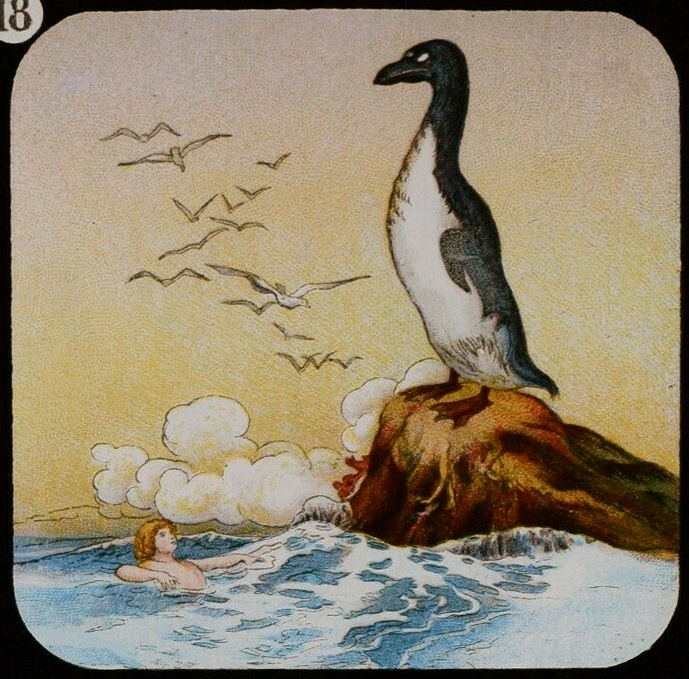 |
|
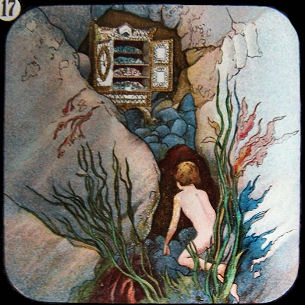 |
||
| 16. Tom and the Good Fairy. | 17. Tom finds where the Sea Bull's Eyes are kept. | 18. Tom asks the way of the last of the Gair Fowl. |
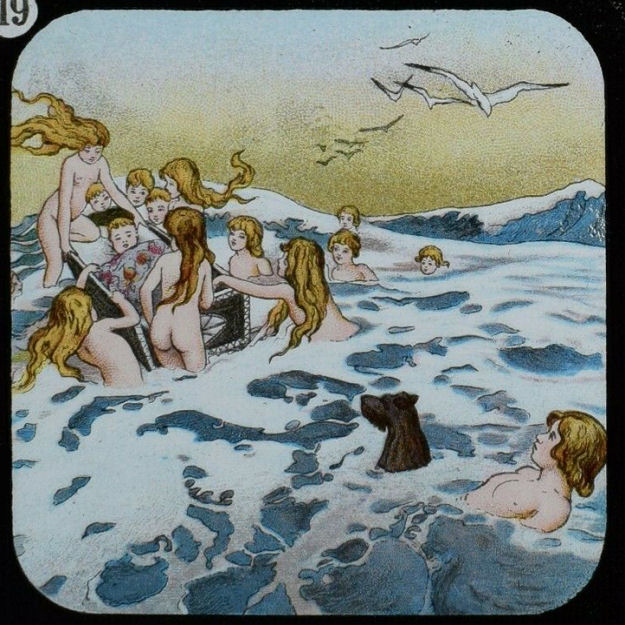 |
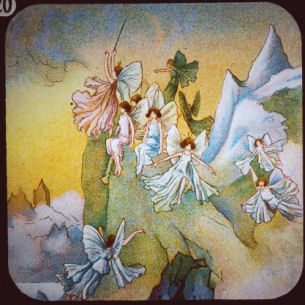 |
|
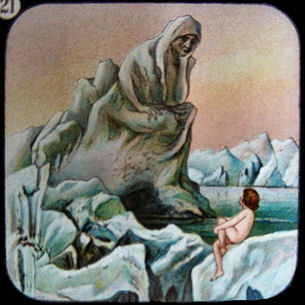 |
||
| 19. The Fairies carry the Shipwrecked Baby to their home. | 20. The Ice Fairies on Shiny Wall. | 21. Tom sees Mother Carey. |
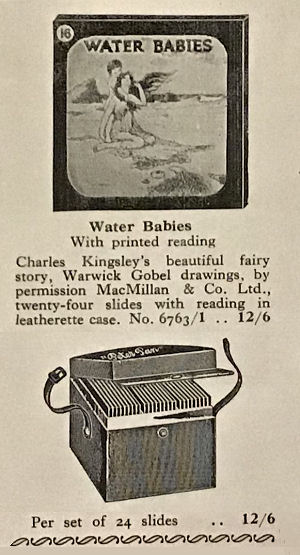 |
The slides | |
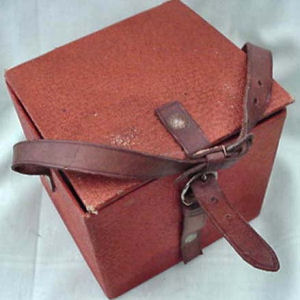 |
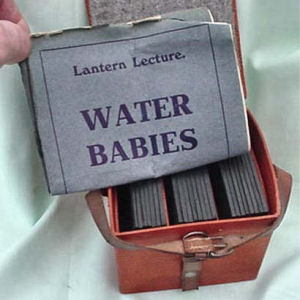 |
|
|
This wonderful set of
twenty four slides from Charles Kingsley's famous children's story 'The
Water-babies', is packed in a large padded fabric covered box with three
sections. Included is an 8" x 5” booklet with 8 pages that tells the
complete story. The beautiful illustrations are by Warwick Goble. The slides were produced by W. Butcher & Sons in London, the company that also produced the well-known Primus Junior Lecturer's Series of lithographic slides. The complete set contains three chapters (8 slides per chapter). Slides are 3 1/4" square. |
||
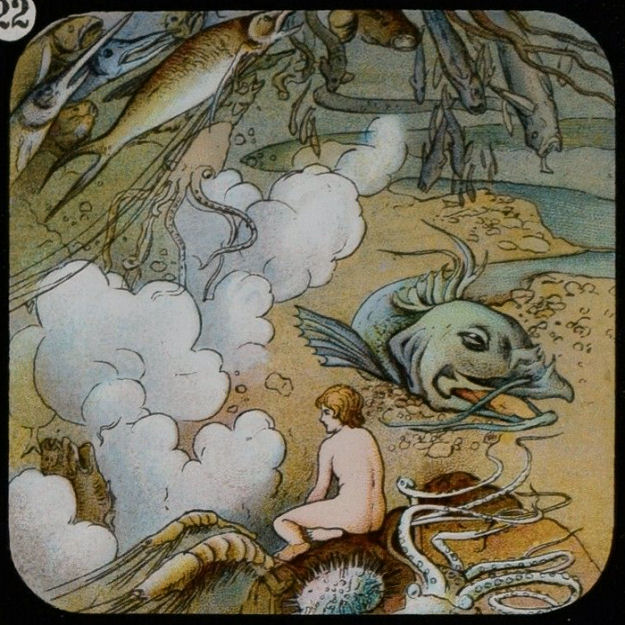 |
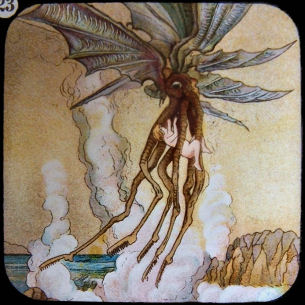 |
|
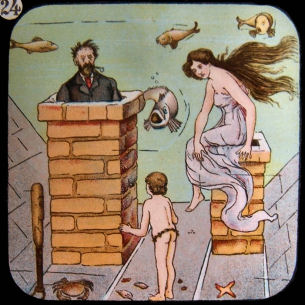 |
||
| 22. The Great Sea Serpent lying dead. | 23. In the legs of a Great Bogey. | 24. Grimes stuck fast in the chimney. |
 Those that wish to be clean, clean they will be; and those that wish to be foul, foul they will be.
Those that wish to be clean, clean they will be; and those that wish to be foul, foul they will be.
the
Irishwoman in The Water-babies. |
||
| |
©1997-2022 'de Luikerwaal' All rights reserved. Last update: 20-03-2022. |